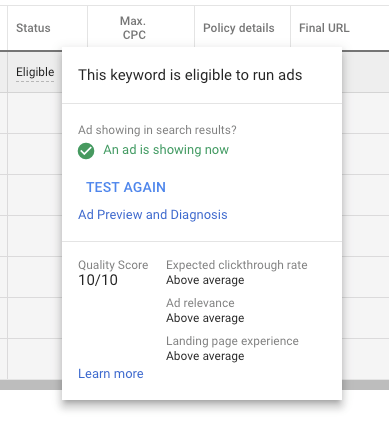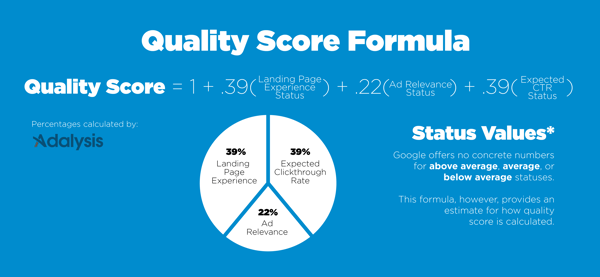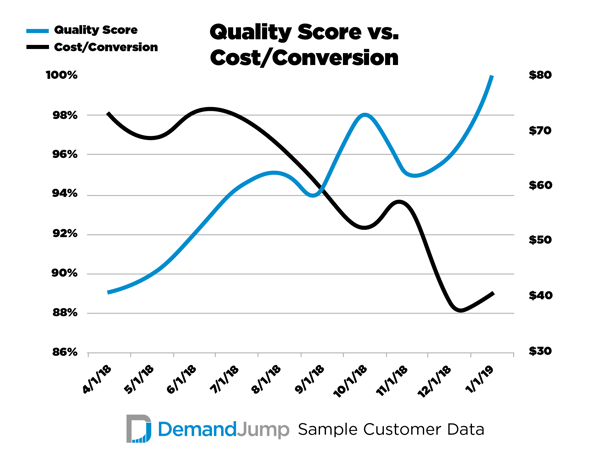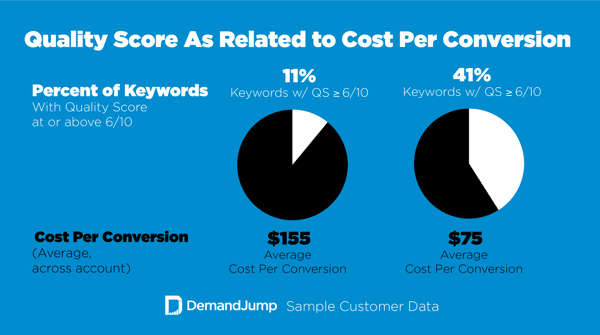What is quality score?
Quality Score is Google’s metric (on a scale of 1 to 10) of your ads’ overall quality and relevance to the keywords you bid on. It is based on previous performance data and is used to help advertisers improve future paid search performance.
Keywords are given a Quality Score that is graded by three components of your Google ads: expected clickthrough rate, ad relevance, and landing page experience.
Basically, it’s Google’s way of creating a positive experience for those navigating Google Search. Because having a higher quality score reflects the need to pay less for PPC ads, it incentivizes advertisers to give people what they came to Google for. It ensures that when you search for “red zip-off pants” the most relevant result shows up first, instead of the advertiser paying the most.
(Everyone needs a good pair of zip-offs.)
Common Myths
Quality Score is not actually used in real-time auctions to determine ad rank. In Google’s words, it is “an aggregated estimate of your overall performance in ad auctions.” So, Quality Score is instead a reflection of your previous ad performance to show how you can improve in the future.
In real-time auctions, ad rank is determined by more specific signals, including but not limited to, the components of quality score. Additional weighing factors of ad rank include: the context of the search, ad and landing page quality, your bid, and expected impact of your ads’ extensions.
Components of quality score
Quality score is determined by 3 main components: expected clickthrough rate, ad relevance, and landing page experience. These three components are given a status of above average, average, or below average to determine the ad’s overall quality score. You can find these statuses by clicking into your keyword and hovering over its status, as shown below.

Expected clickthrough rate
Expected clickthrough rate is calculated using the historical clickthrough rates of your ads and others’ using the same keywords. It is reflective of how closely the keywords you’ve chosen align with the search terms used in real-time that trigger your ads. The outcome of greater alignment here is more ad clicks, and a higher clickthrough rate.
Ad relevance
Ad relevance refers to how closely your ad's content relates to the keywords you bid on. So if you bid on “advertising” but make no specific mention of it in the ad, you will likely receive a status of “below average” here.
Landing page experience
Landing page experience measures how relevant and useful your landing page is to someone who clicks on your ad. If visitors often bounce, not finding what they were looking for, or the page takes too long to load, your landing page experience will suffer. And in turn, your quality score will pay the price.
Component Breakdown

AdAlysis reverse engineered quality score outcomes to estimate the impact of improving the three components: Landing Page Experience, Ad Relevance, and Expected CTR. The three were found to hold weights of 39%, 22%, and 39%, respectively. Although all three are important to improve ad performance, this research suggests that focusing on landing page experience and expected clickthrough rate may make a larger impact on quality score than ad relevance.
How to check quality score in Adwords

By clicking into your keyword in AdWords, you’ll find a column titled “Quality Score”, where you’ll see your quality score out of 10. If you’d like add additional columns to display statuses for individual quality score components, Google offers specific instructions to do so here.
Why improve it?
We’ve taken a subset of our customers’ performance metrics (shown below) to understand the relationship between quality score and cost per conversion, and found there to be close to an inverse relationship between the two - with a correlation coefficient of 0.78. Meaning, improving your quality score can dramatically decrease the price you pay for ads and improve your ad performance.

This relationship between quality score and cost of advertising makes sense from the perspective of both Google and consumers though. As mentioned earlier, people want a relevant experience when navigating Google. So, the only way they will convert on your ads is if you truly offer what they want, when they want it.
Case study of improving quality score

As illustrated above, by bringing your quality scores up to slightly above average, you can dramatically decrease your average cost per conversion. You’ll see here that by increasing the percentage of keywords with a quality score of 6/10 up from 11% to 41%, we cut one customer's average cost per conversion in half.
How to improve QS
Improving your Quality Score comes down to improving the three components that make up quality score, which include: Expected Click-Through Rate, Landing Page Experience, and Ad Relevance.
As mentioned in the quality score formula section above, Landing Page Experience and Expected Clickthrough rate are estimated to hold a higher weight in calculating overall quality score. Knowing this, a great place to start improving quality score is with the keywords you’re bidding on.
Improving expected CTR
Bid on keywords and phrases that are actually used to discover products like yours in Google. Expected clickthrough rate largely comes down to how closely your keyword targeting aligns with actual search behavior. If someone’s searching for “red canvas shoes”, and they see an ad for “red canvas shoes”, they’re more likely to click on it because it’s exactly what they’re looking for.
To understand search behavior, you can use a number of tools including Neil Patel’s Ubersuggest or DemandJump’s Traffic Cloud®. With Ubersuggest, you can identify the search volume of any keyword you type in as well as the competition for that keyword. DemandJump’s Traffic Cloud® allows you to prioritize keywords by how much traffic they drive to your competitors sites as well as your own site.
Once you’ve gathered a good understanding of the search terms used to find products like yours, try to align your keyword bidding as closely to those terms as possible. The greater alignment there, the more likely someone is to click on your ad.
Improving landing page experience
Explained in the video above, once you’ve identified the keywords you would like to own, make sure they’re actually mentioned on your landing page. This signals to Google that you’re actually selling what you say you’re selling. It also creates a better experience for consumers when they navigate to your page and find what they’re looking for.
Another way to improve landing page experience is to add images with appropriate alternative text. This helps users navigate your page with visuals leading the way. Relevant alt text offers additional signals to Google that you are indeed talking about what you say you are.
For more specific information on improving landing page experience, see this blog.
Improving ad relevance
Ad relevance is one of the easiest components to test in a short timespan. Because you can launch multiple ads at once, you can quickly gather data on which ad copy has the highest ad relevance and clickthrough rate, and iterate with the information provided in Adwords.
Running multiple ads also allows each ad and ad group to have greater focus with less keyword muddying. We recommend limiting your keyword use to more specific searches so that your ads always show up in the most relevant places.
For more information on ad relevance and how to improve it, see this blog.
Free Quality Score Assessment
Looking for help improving your quality score? DemandJump offers a free growth assessment for your paid search efforts, detailing your current performance and highlighting new opportunities for improvement. Our assessment ensures that you’re tracking the right metrics and starting out on the right foot to tackle paid search effectively.
One specific aspect you’ll want to check out is your quality score metrics. Here, you’ll be able to see your PPC spend from a 30,000 foot view to see the room for improvement before you. Then, you’ll be able to drill down to the keyword to know specifically where to start.
Hopefully this page was a helpful resource to start working smarter, not harder, within paid search today.






